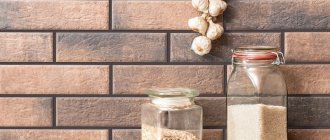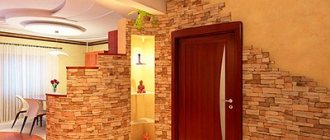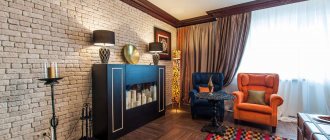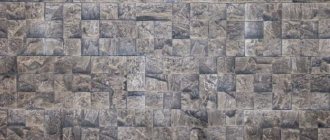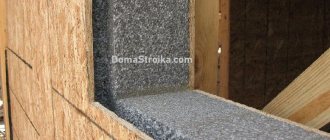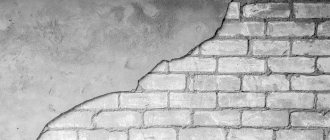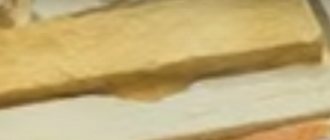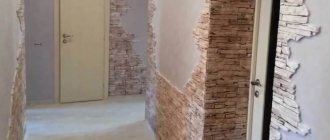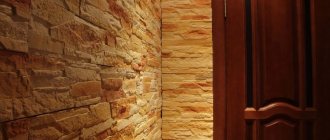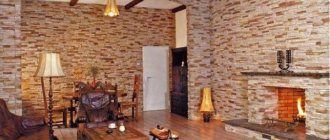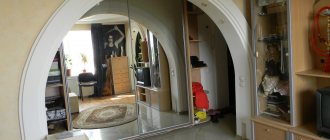Natural stone is the oldest building material, which was used by primitive tribes and legendary ancient peoples. Soon only the rich could afford beautiful and high-quality stone houses. But now everything has changed, and decorative stone has begun to be actively used in the interior. After all, outwardly it is almost indistinguishable from the real thing, but it is cheaper and easier to work with!
What it is?
In fact, decorative stone is a specific tile. It is distinguished from finishing tiles by its texture, which imitates real rocks. It is used for external and internal work, in particular in interiors.
There are several reasons for this: ease of maintenance and operation, ease of processing and installation, cost lower than that of natural granite or marble.
The material itself is lighter in weight. Dirt, grease and other stains are easily washed off from the coating. The homogeneous structure ensures high strength of the material, and the accuracy of the geometry is achieved through artificial manufacturing. Artificial stone is resistant to moisture, parasites, fungus, mold, temperature changes and other external influences.
Acrylic stone
The interior walls of a room are often decorated with acrylic stone, which has many advantages, including:
- Resistance to mechanical damage.
- Resistant to moisture.
- No attraction of dust and dirt.
- Easy to install and maintain.
- Small mass.
- Environmental Safety.
Types of decorative stone
The properties of decorative stone depend on the material from which it is made. Be sure to take this into account when choosing, because the characteristics may vary significantly.
Decorative concrete stone
The composition includes cement, sand, plasticizers, reinforcing components, pigments and fillers. Expanded clay, pumice, and ceramic chips are most often used. This is the most common and versatile type.
Concrete is a very flexible material and a lot of impurities or additives can be introduced into it. Therefore, it allows you to create an imitation of almost any natural stone.
The finished tiles are used for wall cladding. But that's not all! Concrete is used to make sidewalk coverings, baseboards, borders, cornices and decor to look like natural wood.
Acrylic decorative stone
This is a facing material with a varied color palette, shapes and sizes. It is absolutely safe and suitable even for bathrooms and bedrooms.
Contains acrylic resins, aluminum hydroxide, pigments and fillers. This is the most repairable decorative stone. The adhesive seams are almost invisible, and the surface can be sanded perfectly.
It is almost impossible to deform acrylic stone; it does not burn and has the highest fire-resistant properties. It can be used in living rooms, bathrooms, restaurants, and medical institutions.
Decorative stone made of gypsum
It is lightweight, inexpensive, practical and accessible. It is pleasant and easy to work with, and it has been used in interiors for many years. The texture resembles sandstone, so most often decorative gypsum stone is painted to match it.
The disadvantage is that it is very sensitive to moisture. It is not recommended for use in the bathroom or kitchen, but it is absolutely environmentally friendly and breathable.
Porcelain tiles
It contains several types of clay, feldspar, minerals and pigments. The mixture is pressed and fired, so this artificial stone is stronger.
But in appearance, porcelain stoneware looks more like facing tiles than a block of natural granite. But it is resistant to temperature changes and is used in heated floors.
Quartz decorative stone
The beauty and elegance of quartz comes at a cost: it requires protection when working with it. Do not allow stone dust to enter your respiratory tract.
But the scope of application is almost unlimited: from internal and external walls to steps, stoves, swimming pools, sinks and bathtubs. Thanks to its high hygienic qualities, it can be used in public spaces: restaurants, salons, saunas.
Artificial quartz stone is not afraid of frost and does not fade. For cutting you will need diamond discs. Thanks to natural wood as a filler, this is a very durable material.
Conglomerate
At its core, it resembles quartz stone. Only chips of natural marble and granite are used for creation. And also – limestone, quartz sand, pigments.
Outwardly, it is almost impossible to distinguish it from the block of natural rock that was in the composition. But it is much lighter. It is the conglomerate that is most often used for countertops and finishing the work area.
Acrylic based decorative material
A practical and beautiful option. Often used by professionals. Its differences are as follows:
- Excellent technical characteristics and properties.
- It is not afraid of moisture, does not absorb it and does not deform under physical and mechanical influence.
- Dirt and dust do not accumulate on the surface, and the cleaning process is carried out by manipulating with a damp cloth. You don't even need to use detergents.
- It is light in weight and perfectly processed.
- Not harmful to people, does not emit toxic substances. It is used for cladding children's rooms.
The sizes and colors are varied, which allows the products to be used to create any interior. Like other artificial stones, it does not burn and lasts a long time.
Decorative stone in the hallway
Finishing with decorative stone will decorate even a small and cramped hallway. It will immediately look more comfortable and elegant, especially in light colors.
The stone decoration will be complemented by forged elements, lantern lamps, mirrors in massive antique frames.
Turquoise color in the interior: 100 photos and design ideas
What textures are used in cladding?
The choice of texture depends on the room in which the masonry is planned . For example, in the kitchen, you should not use a coating with a complex texture - it will be difficult to clean it from drops of grease and dirt (you will learn how to decorate a kitchen and hallway with decorative stone here). Different rooms will require stones with different characteristics:
- For a bath or sauna, moisture resistance and heat resistance are important.
- In the living room, on the contrary, such masonry qualities are unlikely to be useful.
Decorative stone in the kitchen
The dense, homogeneous structure, as well as high mechanical strength, make it possible to use decorative stone for cladding the work area and even for making countertops.
It does not absorb odors and stains; just wipe the stained surface with a cloth. And there are no scratches or damage from pots and pans on the countertop.
Porcelain stoneware products
Porcelain tiles are a type of ceramic products. The finishing stone made from it is stronger and more durable due to the high density of the material. The composition of this finishing material:
- clay;
- feldspar;
- minerals;
- coloring pigments.
Some features of decorative porcelain stoneware cladding:
- To make products, you will need to use several types of clay to increase the strength of the finished material. The raw materials are pressed and then fired at temperatures above 1000 ⁰C. Thanks to this, it gets its strength characteristics and moisture resistance.
- The materials vaguely resemble decorative stones. They look more like glass tiles made of a certain color. The advantage of the product is that it is durable and reliable. Temperature changes are not scary for him. In addition, due to its high density, it will not absorb moisture.
Note! Cleaning of porcelain stoneware products should not be carried out using abrasive cleaning agents. They disrupt the appearance of the material. Experts also do not recommend using porcelain stoneware to decorate a kitchen backsplash. After all, it is very difficult to clean greasy stains from its surface.
Decorative stone in the bathroom
The bathroom is primarily about humidity and temperature fluctuations. Therefore, durable stone finishes are as common as ceramic tiles.
The stone surface is easy to clean and process. Hygiene is the most important requirement for finishing a bathroom.
Some types of artificial stone are used to make the bathtubs and sinks themselves. The material does not absorb moisture, does not mold, does not rot or peel off.
Stretch ceilings in the interior of an apartment (200 photos)
Varieties of products for decorative finishing
As the demand for finishing products grows more and more, its quantity on the market is rapidly increasing. It is clear that not everyone can afford natural stone, so product categories are divided into two types:
- natural;
- artificial.
Each of them is good in its own way. The main advantage of artificial is that it is much cheaper, with almost the same parameters. Today you can see the following types of decorative stone:
- Made from concrete.
- From porcelain stoneware.
- Conglomerates.
- Acrylic products.
- Based on quartz.
- Gypsum products.
The characteristics of each of them are slightly different, but the method of creating and shaping the products is different. We will take a closer look at these types of artificial stone for interior decoration in order to understand the difference.
Decorative stone in a children's room
Stone finishing fragments look perfect in themed children's rooms. For example, stylized as a castle or dungeon.
From small colorful elements you can lay out frames, mosaics and artistic panels, just like from real pebbles. You can even do this with your child - he will probably enjoy creating something with his own hands.
Tips for choosing artificial stone and its installation
Very thin material glued to a pressed wood base may lose its appearance over time due to swelling of the base, especially when using the material as a tabletop. Any material must be selected in accordance with the type of use, since the thickness of the material for walls or window sills differs significantly.
Materials used outdoors must also comply with the parameters, unless they imitate natural boulders or large stones of non-standard shape. Artificial stone, regardless of the type and production technology, always and everywhere finds its application. In addition, many are inclined to choose this particular material, since the price of such stones is not as high as that of natural ones.
Decorative stone on the balcony
Resistance to external influences is especially important when cladding balconies and loggias. The material is not afraid of either frost or heat. It does not crack, swell, warp, or require regular maintenance like wood.
Decorative stone looks especially interesting in improvised winter gardens and greenhouses on the balcony.
Gray color in the interior: design ideas (100 photos)
Types of facing stone
The task of facing stone is not only to protect this or that surface, but also to give it an attractive appearance. Depending on what the base will be and what stone is used, the type of masonry is used.
* Cladding for masonry from a die. Often used for finishing houses, sandstone and slate are used. They have excellent properties and are not heavy, they are easy to work with, and are considered the cheapest stones for external cladding .
* “Castle” cladding - masonry using natural stone tiles. An imitation of castle walls from the Middle Ages is created, the surface acquires convexity and relief. Masonry is widely used for cladding facades; slate, marble, sandstone, and limestone are used as materials.
* “Plateau” cladding - laying rectangular or square tiles. The surface of the tiles can be either flat (similar to a plateau) or embossed. Most often used for plinths marble, slate, sandstone or limestone are used as facing stones
* “Shahriar” cladding - masonry using rectangular tiles made of natural stone. Installation does not require much effort; here you can accurately calculate the amount of material. Perfectly imitates the surface of medieval and ancient buildings.
* “Assol” cladding - masonry using thin rectangular relief materials. Allows you to create unique volume, depth and uniqueness of the facade. It is sometimes difficult for craftsmen to guess the amount of material; everything is done as the masonry is being laid.
* “Rondo” cladding - masonry is designed for different facades ; sea cobblestones are used as facing stone . They are a pleasure to work with because they come in different sizes and are already sanded.
Decorative stone and interior styles
The use of stone finishing is not limited to one style. The wealth of textures and shades opens up endless possibilities for designers.
Classic interiors
Luxurious and elegant stone cladding is the most important attribute of pompous classics, baroque, rococo and empire. Marble of different shades is found on walls, floors, in the form of panels and inserts.
The stone texture is interestingly intertwined with modern trends in neoclassicism. She managed to get rid of excessive decorativeness and a clutter of accessories, so inserts for valuable species look even more impressive.
Decorative stone in the loft
In a rough industrial loft, stone cladding looks like home. Make it deliberately careless - choose slabs with raw texture, unevenness, and abrasions. Too neat and elegant stone decoration is inappropriate in a loft.
Decorative stone in modern style
Modernism is smooth and soft lines, natural textures, natural asymmetry, complex shades. Decorative stone is easy to process, so it can be given any desired shape.
But avoid strict rectangular plates and slabs of regular angular shape. But the mosaic, round panels, arches look like family.
Decorative stone in minimalism
Minimalism strives for simplicity, conciseness and functionality. Artificial stone is fully suitable for these tasks.
Decor in minimalism is based not on accessories, but on textures and accents - stone inserts will be such an accent. Solid finishing is rare, but several elements look impressive and will help zone the space.
Decorative stone in high-tech
High-tech tends to artificial textures and materials. But decorative stone perfectly imitates the texture of natural stone. It may seem like it doesn't belong in this style, but it doesn't!
Of all the natural materials, cold and hard stone is the easiest to fit into modern technological and futuristic styles. Give it an angular, irregular shape, choose cool black and white shades.
Decorative stone goes well with metal, glass and acrylic - typical high-tech materials.
A short tour of installation
The correct choice of facing material is a very important thing. But if it is poorly installed, then it may happen that you will soon get a headache. Therefore, when gluing stone tiles, you need to follow simple but mandatory rules.
- In addition to the decorative material itself, you need to purchase glue that corresponds in composition to its characteristics, a primer, a water repellent, a jointing mixture and a fiberglass mesh with a cell size of 5 * 5 mm.
- The tools you will need are a level for marking, a drill whisk for mixing, a trowel, a notched trowel and a jointer for seams. You can cut stone using a grinder with a diamond blade or a circular saw.
- To clean stone surfaces, you will need brushes with metal and plastic bristles. You will also need several brushes of different sizes for applying the compounds and smoothing the seams between the tiles.
Step 1 – stock up on everything you need
Step 2 – the wall must be leveled, but it is not necessary to smooth it too much
Step 3 – the surface must be primed
After everything you need has been prepared and the wall has been leveled and primed, you can begin to work. Mix the glue in a clean container in small portions so that you have time to use it quickly. First, measure out the dry mixture, then mix it with water according to the instructions. You can knead by hand, but using a mixer will give you better results.
Step 4 - make the batch
While the adhesive mixture is “resting,” cut the mesh in the desired format. It is fixed to the wall with a few strokes of glue, after which it is applied over the entire area. Leave the armor layer to dry, and at this time lay out the dry tiles on the floor in the order in which you will lay them.
Step 5 – cut a piece of mesh to size
Step 6 – fix the grid on the wall
Step 7 – dry laying the tiles
You begin marking after the mesh-reinforced section of the wall has dried and primed. Using a square, level and pencil, mark all the rows on the wall, adding a margin of 8-10 mm for the seams. Before gluing, the back side of the tiles is cleaned with a wire brush so that there is no dust or dirt on it.
Step 8 - measuring the width of the facing element
Step 8 – transfer the size to the wall vertically
Step 9 – marking the horizontal rows
The glue is applied not to the wall, but to the tiles with a simple spatula, after which its excess is removed with a notched spatula. Let us note once again that during installation you need to remember the need to leave side and inter-row seams. Using the appropriate tool, the jointing mixture is placed in them - it is compacted, and its grains are brushed with a dry brush. At the final stage, the lined surface is coated with a water-repellent agent, which will protect it from the penetration of moisture and dirt.
Step 10 - Applying Glue
Step 11 – Remove excess glue with a notched trowel
Step 12 – gluing the tiles
Step 13 – laying jointing mixture into the seams
All types of artificial stone are installed in the same way - concrete, gypsum, clinker. To make the process more clear, we suggest watching the video.
Prices for various types of glue Osnovit Maxiplix
Glue Osnovit Maxiplix
Video - How to lay artificial stone yourself
Laying decorative stone
Covering surfaces with decorative stone is almost no different from laying tiles. You will need cement mortar or glue, a level, and spatulas. The stone is laid only on a flat base. To do this, use plaster or drywall. Large differences in level will help to hide the profile design.
Seal all seams and joints. Apply several layers of plaster, sand each of them with sandpaper. Clean the surface from dust, use a primer or primer to improve adhesion.
Apply a small layer of the adhesive mixture directly to the surface and leave for a few seconds. Apply another thin layer of mortar to the inside of the stone slab. Lay the stone on the base - the slabs are laid closely, with cross dividers.
After the mixture has set, seal the seams and minor defects with decorative putty. To add shine to the surface of the decorative stone, use a special varnish.
Types and features of stone for wall decoration
Thanks to a wide range of shades, textures and methods of laying artificial stone on the wall, you can choose the most interesting option for your interior.
How to properly lay decorative tiles on a wall will be described below.
It is important to understand the difference, there is:
- Natural facing stone;
- Decorative tiles - imitation.
From natural stone, preference is given to tiles made of sandstone, limestone, shell rock, basalt, tuff and granite. Used frequently:
- Natural marble. Elite cladding, its reserves are almost exhausted, but hard synthetic analogues are produced. Among the popular shades are white and black marble, beige, reddish and olive shades of this stone.
- Hewn sandstone slabs. There are fine-grained textures, coarse-grained and medium-grained batches. Lots of milky, reddish and chocolate shades are available. Sandstone looks good in mosaic layout and chaotic alternation of multi-colored slabs.
- Granite. Traditional facing material, not very heavy, can be processed. The cladding will decorate the hallway, living room, or any other room. Smooth slabs can be laid on the floor.
- Naturally polished sea pebbles. Suitable for combined laying of decorative stone on the wall with your own hands. Heavy weight, non-standard shape and questionable aesthetics complicate the application. But this material can be found on the seashore and used in some design solutions.
- Limestone (shell rock) is a dense structure of marine calcium. The material is cut into slabs for laying in rows. The most common varieties are milky, gray, yellowish and pinkish.
- Slate. It is distinguished by a characteristic texture, thanks to which it is laid with jointing and “seamless” laying of decorative stone on the wall.
Synthetic and composite materials are widely used. Natural stone chips are poured into a transparent polymer base, from which countertops and slabs are made. It imitates onyx, jasper or malachite.
Artificial “stone” will enhance any interior thanks to its interesting texture. A wider variety of decor is produced on an environmentally friendly basis:
- Gypsum;
- Cement.
Gypsum boards are lightweight but fragile. Without additional preservation with colorless varnish, gypsum stone is unsuitable for rooms with fluctuations in temperature and humidity. Practical cement-based decor is a universal finish for facades and interior spaces without heating.
Artificial “stone” will enhance any interior thanks to its interesting texture.
Decorative stone in the interior - photo
The scope of application of decorative stone in interior design and decoration is almost limitless. Therefore, feel free to fantasize and experiment for your own pleasure. And for your inspiration, we have put together this photo selection!
Did you like the post? Subscribe to our channel in Yandex.Zen, it really helps us in our development!
DOLOMITE
Sedimentary rock consisting of the mineral of the same name; “relative” of marble.
Color palette: colorless or white, yellowish, brownish (due to the admixture of iron hydroxides and clay particles), shiny - from glassy to matte and pearlescent; often has a fancy pattern. Occasionally valuable pink dolomites are found, as well as translucent and transparent ones.
Physical properties: durability, frost resistance, high strength, fire resistance; easy to process; hard grades are polished.
The structure of dolomites is marble-like, porous and dense. The latter are used to make facing slabs for the exterior decoration of buildings. These are the famous Myachkovsky, Kovrovsky and Korobcheevsky dolomites, which have been used since ancient times by Russian architects in the construction of white-stone churches. Porous varieties are used in garden design.
Application:
- interior and exterior decoration of premises
- landscape design (dry walls, supports)
- paving paths and platforms
Peculiarities
Decorative stone is made from different materials - acrylic, gypsum and concrete. For interior decoration, gypsum stone is used, and for exterior decoration, concrete stone is used, made from concrete with sand or stone chips.
In order for the artificial stone to acquire a certain shade, various dry dyes are used and added to the solution.
In the photo of decorative stones you can see that the material can have not only a different color, but also a different texture. The stone is cast in special molds; you can give it a smooth or rough texture.
Photo
Stonington ResidenceRead: Penthouse design - photos of the most fashionable and unusual interior design solutions
Let's discuss this article together:
Click to cancel reply.
